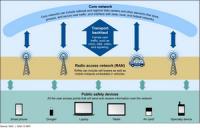-
Rapid DNA technology ID’ed California wildfire victims
Amid the chaos and devastation of a mass casualty evet, medical examiners often provide closure as they identify victims in the aftermath, but their ability to do this quickly can vary depending on the size, scope, and type of disaster. Such challenges were the case following the Camp Fire wildfire that killed eighty-five people and devastated communities in Paradise, California, in the fall of 2018. S&T’s Rapid DNA technology became the first resort as it provided identifying information in under two hours when dental records and fingerprints weren’t available.
-
-
Abundance of DNA evidence insufficient to prevent wrongful convictions
As we enter an era in which DNA evidence is routinely used in criminal investigations, errors that led to wrongful convictions—including mistakes later corrected with DNA tests—may seem to be fading into history. This, however, is not true, says an expert.
-
-
S&T seeking partners for first responder technology R&D

DHS S&T said it was inviting industry, academia, laboratories, and the innovation community to submit white papers related to twelve first responder technology funding opportunities. S&T said that each of the twelve topic areas “represent technology needs identified by responders themselves, and we are seeking the best partners to turn these needs into solutions.”
-
-
Detecting, analyzing suspicious activity in surveillance footage

Traditional surveillance cameras do not always detect suspicious activities or objects in a timely manner. Researchers developed a hybrid lightweight tracking algorithm known as Kerman (Kernelized Kalman filter).
-
-
Polymers help minimize fuel explosions and fires from accidents and terrorist acts
When an act of terrorism or a vehicle or industrial accident ignites fuel, the resulting fire or explosion can be devastating. On Tuesday, scientists described how lengthy but microscopic chains of polymers could be added to fuel to significantly reduce the damage from these terrifying incidents without impacting performance.
-
-
Turning incident scenes into virtual 3D models
When officers arrive at a crime or crash scene, they have to spend a lot of time looking for evidence, processing it, taking photos of it, and documenting. To help make this process more efficient, the Department of Homeland Security’s (DHS) Science and Technology Directorate (S&T) has teamed up with the Israeli Police to invest in a new tool.
-
-
Improving canine detection of explosives

The Department of Homeland Security (DHS) Science and Technology Directorate (S&T) has awarded $564,988 in funding to Auburn University for two research and development (R&D) projects designed to improve the effectiveness and efficiency of canines trained to detect explosives.
-
-
Satellite technology detects, and may prevent, genocide
Many of the world’s worst human rights abuses, including genocides, occur in areas that are difficult to observe. “Smallsat” — short for small satellite — technology can detect human rights abuses and violations. The information collected by this technology provides evidence that can be used to corroborate refugee accounts of atrocities in international courts.
-
-
Cyber toolkit for criminal investigations
cybercrimes reached a six-year high in 2017, when more than 300,000 people in the United States fell victim to such crimes. Losses topped $1.2 billion. Cybercriminals can run, but they cannot hide from their digital fingerprints.
-
-
New periodic table of droplets could help in solving crimes
Liquid droplets assume complex shapes and behave in different ways, each with a distinct resonance – like a drum head or a violin string – depending on the intricate interrelationship of the liquid, the solid it lands on and the gas surrounding it. Researchers have created a periodic table of droplet motions, inspired in part by parallels between the symmetries of atomic orbitals. Better understanding of droplets behavior may help solve crimes.
-
-
Cold-case investigation is helped by forensic artist
remains on an unidentified person. “Without knowing who the victim is, it is nearly impossible to find a suspect,” said Lance Krout, lead investigator in the case. “I’ve spent several years working on this and it’s kept me up some nights because we’re not able to move into the next phase of the investigation if we don’t identify this victim.” Penn State 3D experts say they can help the police.
-
-
Drone jamming system to protect European airports, public spaces
Airports could be equipped with technology capable of detecting and bringing down drones that stray into their air space, according to Dan Hermansen, chief technology officer of Danish anti-drone firm MyDefence. The company has developed a drone alarm and protection system that is being installed at a number of prominent sites around Europe, including an airport. It has the potential to prevent the kind of costly disruption that hit London’s Gatwick and Heathrow airports recently.
-
-
Carrying Tasers increases police use of force
Cambridge University experiment with City of London police found that, while rarely deployed, just the presence of electroshock devices led to greater overall hostility in police-public interactions – an example of what researchers call the “weapons effect.”
-
-
TSA’s roadmap for airport surveillance moves in a dangerous direction
The Transportation Security Administration has set out an alarming vision of pervasive biometric surveillance at airports, which cuts against the right to privacy, the “right to travel,” and the right to anonymous association with others.
-
-
New Australian law would compel tech firms to hand over encrypted data
Australia’s parliament earlier today (Thursday) passed a controversial measure which will force tech firms to give police access to the encrypted communications of suspected terrorists and criminals. The law, fiercely opposed by big tech firms, has engendered heated debate over national security and privacy at a time law enforcement agencies are struggling with how to access encrypted information to monitor illegal activities. The passage of the law may have global implications for encrypted communications. Critics say the law may unleash unintended consequences.
-
- All
- Regional
- Water
- Biometrics
- Borders/Immig
- Business
- Cybersecurity
- Detection
- Disasters
- Government
- Infrastructure
- International
- Public health
- Public Safety
- Communication interoperabillity
- Emergency services
- Emergency medical services
- Fire
- First response
- IEDs
- Law Enforcement
- Law Enforcement Technology
- Military technology
- Nonlethal weapons
- Nuclear weapons
- Personal protection equipment
- Police
- Notification /alert systems
- Situational awareness
- Weapons systems
- Sci-Tech
- Sector Reports
- Surveillance
- Transportation
Advertising & Marketing: advertise@newswirepubs.com
Editorial: editor@newswirepubs.com
General: info@newswirepubs.com
2010-2011 © News Wire Publications, LLC News Wire Publications, LLC
220 Old Country Road | Suite 200 | Mineola | New York | 11501
Permissions and Policies
Editorial: editor@newswirepubs.com
General: info@newswirepubs.com
2010-2011 © News Wire Publications, LLC News Wire Publications, LLC
220 Old Country Road | Suite 200 | Mineola | New York | 11501
Permissions and Policies
